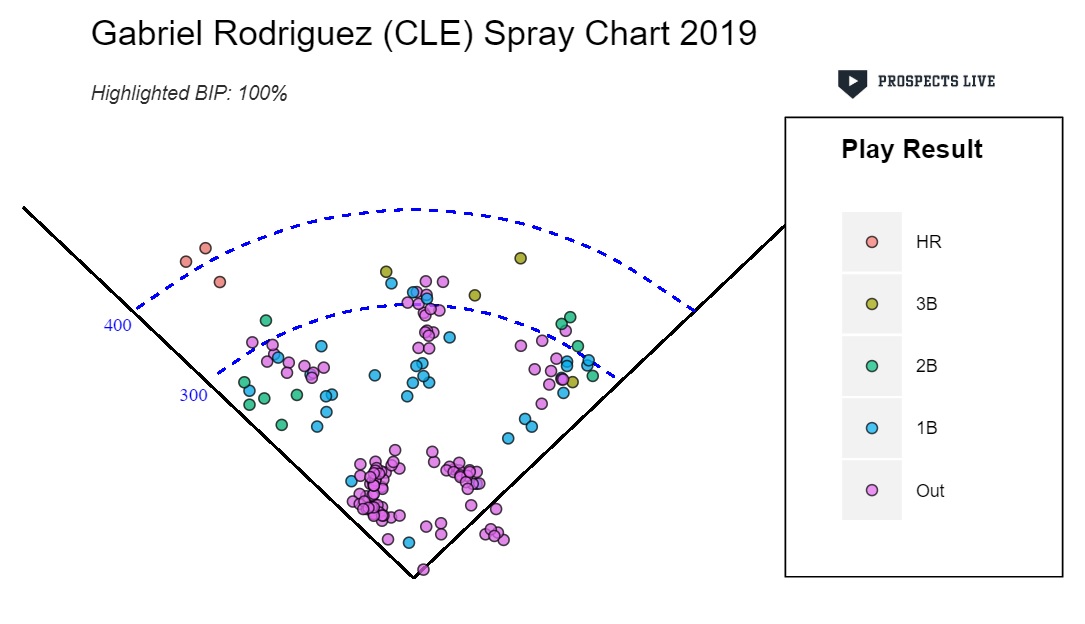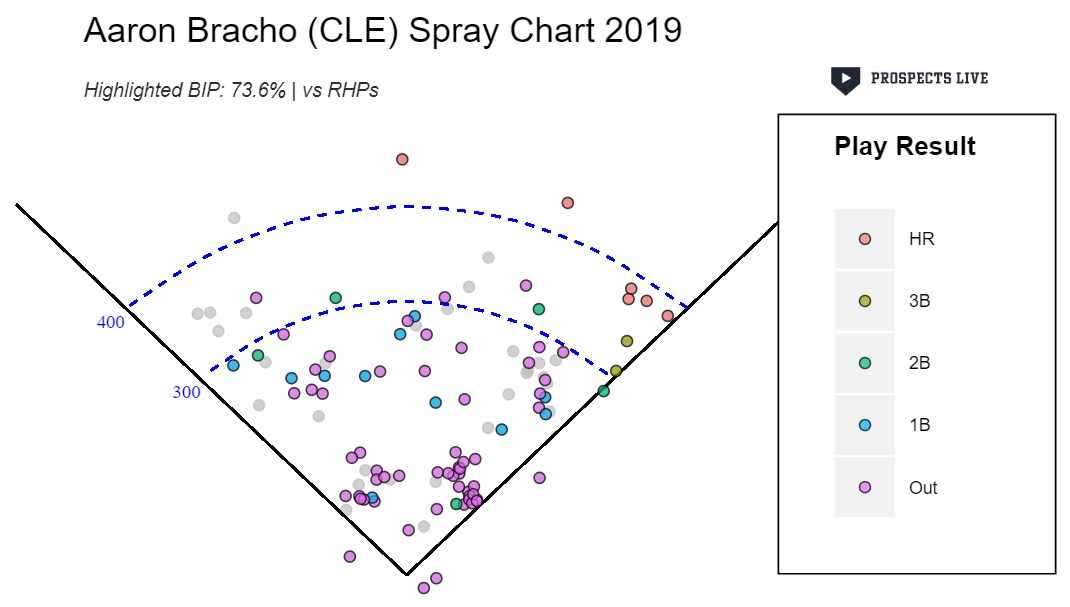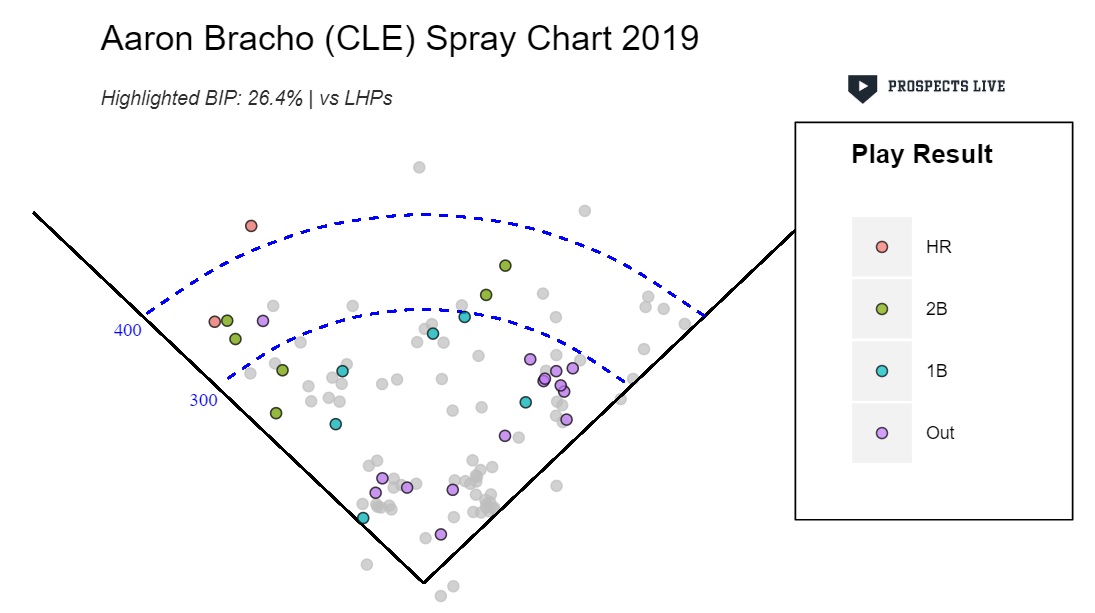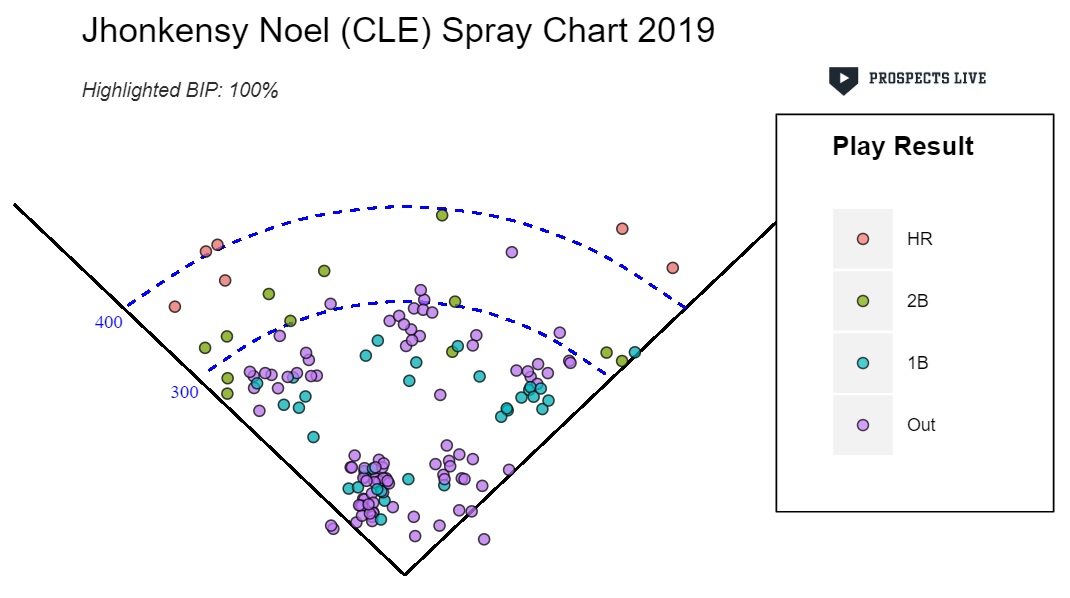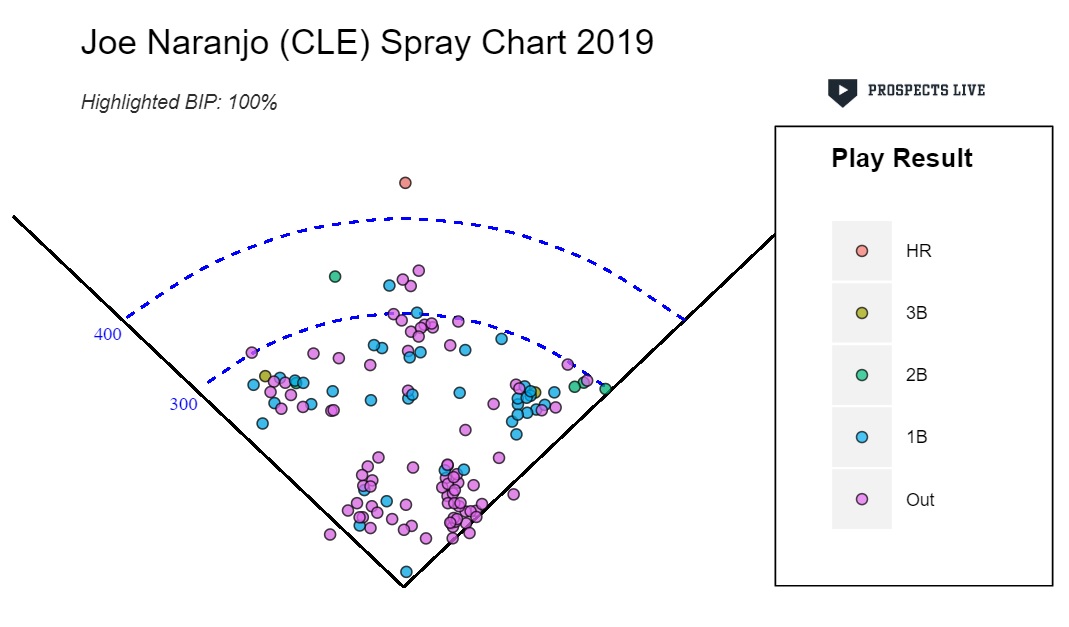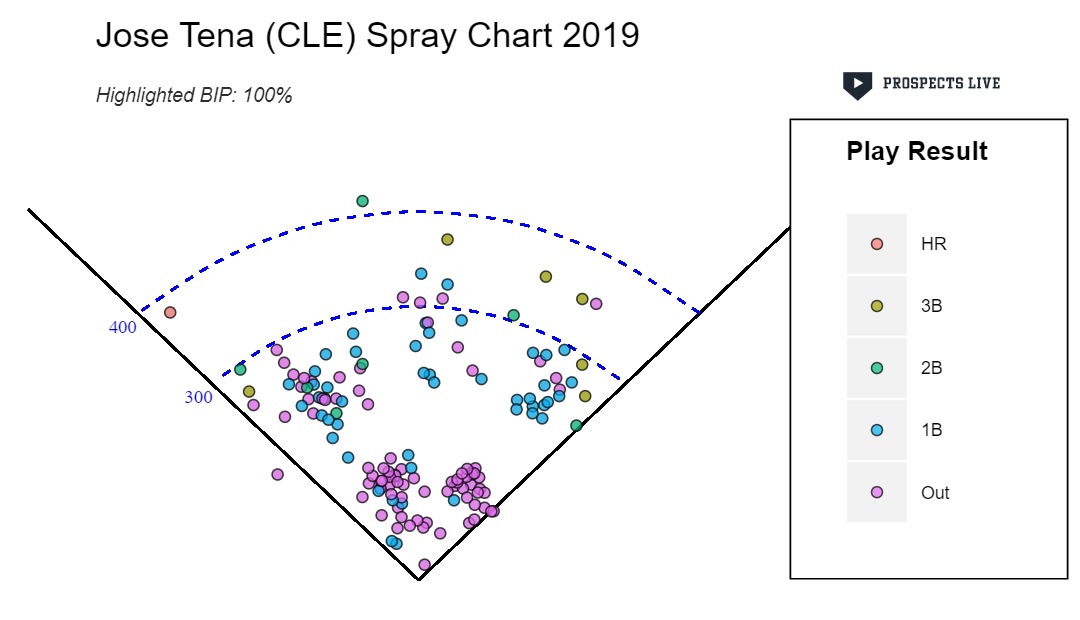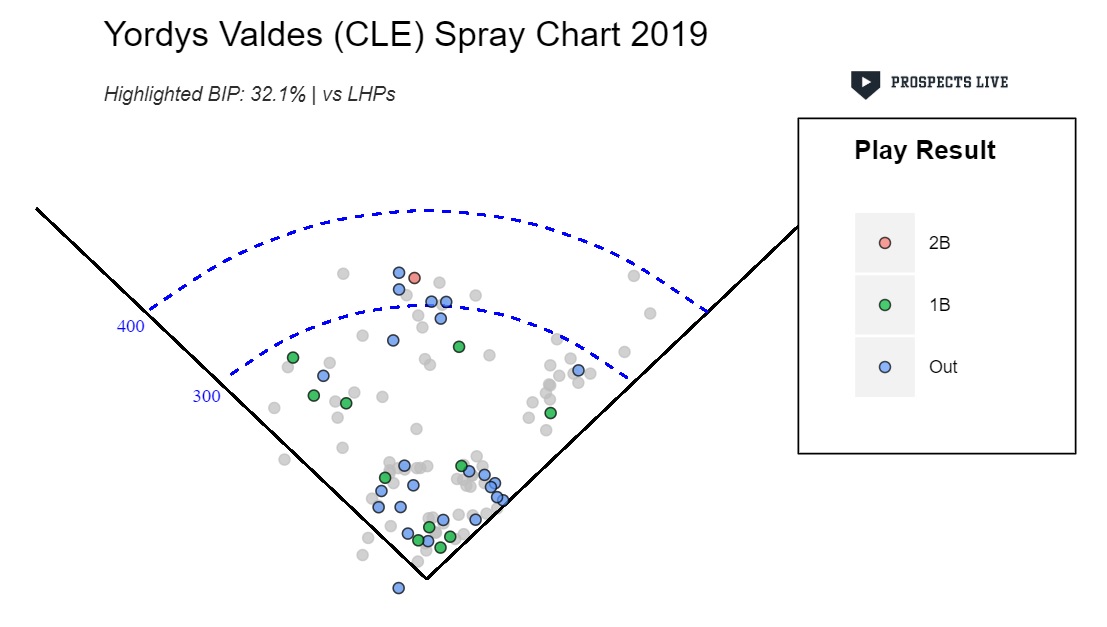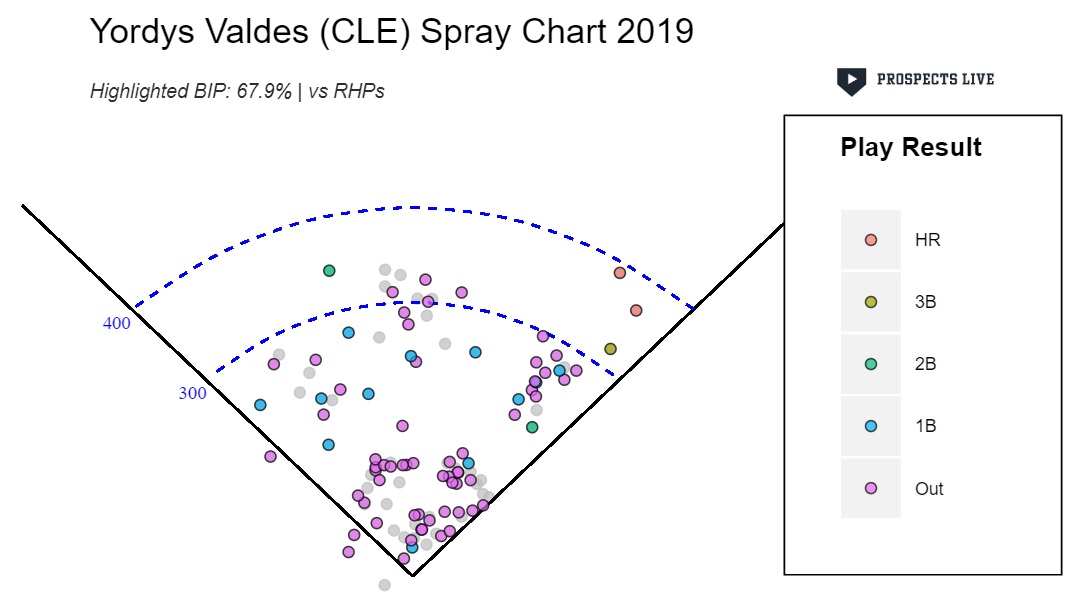The Indians have a loaded complex with a steady stream of talent flowing from international market and the draft. From 8/20-8/26 I bore down on the AZL Cleveland Indians Red. Gabriel Rodriguez and Daniel Espino both have star potential. Rodriguez is a shortstop with strong hands and plus power projection. Espino pairs premium velocity with two breaking balls that flash plus. Yordys Valdes is a quick-twitch shortstop with smooth defensive actions and great hands. I also caught the Indians Blue team a few times in cross-coverage and again in the AZL playoffs. Aaron Bracho was arguably the most-polished hitter in the AZL. Jhonkensy Noel is an incredibly strong (recently turned 18-year-old) first base prospect with immense raw power. Jose Tena is a middle-infielder with easy plus bat speed and impressive bat to ball skills.
Gabriel Rodriguez (SS) – The Indians signed Gabriel Rodriguez for $2.1 MM during the 2018 J2 period. He was regarded as one of the top prospects of the class. In late July, the Indians promoted Rodriguez from the DSL to the AZL, making him one of the youngest players in the league. Rodriguez is (currently) a shortstop who projects for 70 raw power. He has strong hands and a powerful rotational swing. His load and stride can get short, especially in two-strike counts, but his hands and wrists enable big power regardless. Rodriguez’s swing mechanics have been inconsistent. When good, he has strong, well-timed hip rotation through point of contact, generating big power. When bad, he gets flat-footed and flicks his hands through the zone. Pitch selection is an area in which Rodriguez should improve with reps; it has hurt him statistically this season. At times Rodriguez made contact despite flat-footed, handsy swings (often on breaking balls low). I think there is an element of moral hazard in his game: his ability to occasionally connect on these types of swings encouraged him to go after pitcher’s pitches too often, resulting in poor contact. Modest improvements in approach should result in big statistical gains. Rodriguez has unassailable raw power; he has mature physique for his age and his hands are special.
Defensively, Rodriguez is not twitchy at short, but he took solid paths to the ball and had good reactions. His hands and footwork were also playable in the middle infield. Overall the defensive actions were passable, but Rodriguez had below average range for the position. His best home to first was 4.44 on a 4-3. groundout (E3); he is roughly a 40 runner. As his body fills out, he will lose a step, and his long-term defensive home is third base. The arm is also not special but would play there; it is more strong than accurate. He projects as an average regular with average defense at third and an above average bat, but has role 60-upside if he hits more than expected.
Overall: 50 FV – Hit 20/45, Power 30/60, Defense 30/50, Arm 50/55, Speed 40/35
Daniel Espino (RHP) – The Indians took Espino 24th overall in the 2019 draft and signed him for $2.5MM. Espino is a flame-throwing righty with a totally-yoked body that should help him sustain mid-90s velocity deep into starts and withstand a starting pitcher workload. Espino is very muscular throughout; it is hard to imagine a more filled-out 6’2” frame. His legs – thick. His chest – chiseled. His ass – firm. My initial reaction to his body was concern over his flexibility. Would it inhibit the repeatability of his mechanics? The answer – no; he looked flexible and repeated well. Espino incorporates his back leg well and has an efficient lead leg block, which transfers strength from his lower half into his arm. Those who believe he will end up in a pen cite below average momentum (he is slow to home) and his long arm action. The arm action may make it easier for hitters to see the ball out of his hand, but it did not hurt him in my looks.
Espino threw one inning in his AZL debut and sat 97 mph. Three weeks later Espino went three innings in his 8/5 start. He showed above average fastball command, working it to both sides and hitting his spots. The pitch sat 93-96 and touched 98 in this more extended look; it was especially effective tailing away from lefties and boring in on righties. Espino leaned on the fastball and was able to overpower AZL hitters without much else. The pitch generated swing and miss in all quadrants of the zone. Feel for his secondaries was sporadic. The slider (mid-high 80s) and curve (mid-high 70s) both flashed 60, and his changeup (high 80s) was fringe average. Both breaking balls flashed tight shape and good two-plane break, but shape was inconsistent. The curve backed up on Espino a few times as his hand failed to get around the ball. A few sliders were spiked in the dirt. When Espino commanded them in zone, knees buckled, and it was apparent AZL hitters were sitting fastball.
Body language read: Espino has a very stoic, down to business demeanor. Watching him strike out five Cubs on 8/5, he calmly circled the mound and returned to position. He would probably look no different after a strikeout or homer allowed. Espino strikes me as a low blood pressure kid, and this trait should suit him well both in dealing with ebbs and flows of development and in maintaining focus during high-pressure game situations.
Based on these short looks, Espino projects as a role-50 starting pitcher. He has number two upside should the changeup get to average and both breaking balls reach 60. His fastball is already plus, and his ability to command it gives Espino a high floor – something like wipeout reliever. Espino needs to maintain quality shape on both breaking balls as he progresses into the upper minors. Cleveland’s progressive player dev staff give him a good shot to make that happen. Considering the massive amount of muscle Espino has added since coming over from Panama, he seems like a hard worker, which also suggests he has a reasonable chance to realize his lofty role-60 ceiling.
Overall: FV 50 – FB 60/70, CB 45/60, SL 45/55, CHG 30/45
Aaron Bracho (2B) – The Indians signed Aaron Bracho for $1.5MM as a part of their 2017 J2 class. He is a stocky switch-hitting second base prospect who rakes. You could make a case he was the most polished hitter in the AZL this year. Bracho controls the zone; he walked 28 times and struck out 29 in 129 PAs over the course of the season. He swings hard and makes an inordinate amount of contact considering the violence in his swing. Bracho has a pull-heavy approach but can use all fields if necessary. His goal is to crush the ball, and he makes a good amount of hard contact. This kid loves to hit. One of my favorite things to happen all season occurred on 8/25: umpires ruled Bracho was hit by a pitch, and he argued with them because he wanted to stay up at the plate.
The swing itself is generally well-balanced and under control. Bracho uses a light toe tap and settles his hands to shoulder length at slot on time. He has remarkable hand-eye coordination and rarely gets fooled on the same pitch twice in an at bat. The mid-AB adjustments stand out as a skill that should help him hit higher-level pitching. Overall, his quality of contact to all fields coupled with his ability to find barrels make him a reasonable bet to be an above average hitter at the highest level. Defensively, Bracho is below average at second; he will make plays on the balls within his range but is not special. He projects as an above average offensive regular with below average defense.
Overall: FV 50 – Hit 35/55, Power 35/50, Defense 30/40, Arm 45/45, Run 45/40
Jhonkensy Noel (1B) – Cleveland signed Noel in July of 2017 as a shortstop. I was unable to find any information about his signing bonus, but he was listed at 6’1” 180 at signing date and is now closer to 6’3” 240. He is a certified man-child, an enormous human, considering he turned 18 on July 15. His age is notable; Noel was one of the younger qualified hitters in the AZL this year. As you might imagine based on this physical description, he projects for big all-fields power. Like many power-first guys the pivotal question with Noel is how much of it will play in games? I think he gets to something like 40 hit and becomes a fringe-average regular. Noel uses all fields, sees spin and can touch it in the zone. He can still be beaten by well-located spin down, but this feels like reasonable progress relative to where he was in extended when he looked more over-matched. Noel may not be done growing, which is a scary thought. If he gets taller he will have more zone to defend and will be less likely he will reach 40 hit.
Noel played third base in the AZL playoffs, and he checks a lot of boxes for the position: he has surprisingly nimble feet, a quick first step, and good range. His hands, however, are below average, and Noel has poor awareness for the position. He lacks an internal clock and misjudged the speed of runners going home on consecutive plays in 8/29’s playoff game. Instead of taking easy outs at first, he opted to go home and came away with nothing. How much of this can be chalked up to limited reps at the position? Noel played 12 games out of 47 at third during the regular season, and I think that is worth noting. Having said all this, Noel is very athletic for his size, and makes some head-turning plays at first, stretching with full splits to extend the bag or diving to rob hard-hit grounders down the line. His skills should play well at first where he projects to above average for the position. Noel moves well for a big man and is quicker than fast; he posted 30 run times in my looks but looks more like a 40 runner. By the time he fills out he should settle in around 30. The overall package looks something like a fringe-average regular for a non contender or bench player on a first-division team.
Overall: 45 FV – Hit 30/40, Power 40/60, Defense 45/55 (at first), Arm 50/50, Speed 40/30
Yordys Valdes (SS) – The Indians drafted Valdes in the second round and signed him for $1MM. He is a slick, twitchy defender at short with clean actions, good footwork and hands. He takes a lot of short, quick steps, has great body control and is very athletic. Watching Valdes at short is poetry in motion; he moves with a fluidity that is aesthetically pleasing. One body movement flows seamlessly into the next. Valdes is setting himself up for his next motion or throw, much like a catcher blocking a ball and preparing to throw in a single action. On 8/21 I wrote in my notes: “55 arm n.m.e. strong>accr (low throw)” . The arm is above average (more strong than accurate) and also plays at shortstop. Valdes posted a 4.50 from the right on a 4.3. groundout on 8/21. I don’t think this time is indicative of his speed; he looks more like an above average runner with a better first step than top speed.
Valdes’ bat has some question marks, but he has the raw tools necessary to become an everyday regular should he realize his potential. Bat speed is above average to plus; the hands are very good. Valdes is a switch hitter and uses his lower half well. His lefty swing is torque-heavy; Valdes bends his front leg back and uncorks his hips as his hands drop and the bat enters the zone. Despite his thin figure, Valdes has surprising juice in his bat and projects to around 45-50 raw power. The righty swing is more contact oriented but still uses a good amount of lower half, just not as much as the left side. When hitting righty, Valdes has a leg kick that he shortens with two strikes. Secondary pitches have easily over-matched Valdes this summer, and he has gone after fastballs early in counts. Opposing pitchers have had their way with him in two-strike counts with offspeed or breaking balls. His AZL season slash line reflects this and is admittedly discouraging, but Valdes is young for the level and will get another shot at solving AZL pitching in 2020. Whether he will figure out pro-caliber secondaries will go a long way in determining his future role. He has everyday upside, but without seeing more, projects as a defense-first role-40 utility player.
Overall: 40 FV - Hit 20/40, Power 30/40, Defense 50/60, Arm 55/55, Speed 55/55
Jose Tena (SS) - Cleveland signed Jose Tena for $400K during the 2017 J2 period. At the plate Tena is uber aggressive early in counts and makes a surprising amount of hard contact considering his approach. Tena has advanced bat-to-ball skills and plate coverage He will stay back on spin and offspeed and has shown the ability to scoop breaking balls low in the zone, going with them to the opposite field. Tena had the highest opposite field percentage among qualified hitters in the AZL. It’s not an indictment on his bat speed, which is good. Tena’s hands start very high in his pre-swing load, which put him at an inherent disadvantage when pitchers locate low in the zone. Tena is then left chopping down at the ball, resulting in opposite field ground ball contact. He has good hand-eye coordination and often makes contact in spite of his mechanics.
While not as twitchy as Valdes, Tena moves like a shortstop and has defensive chops for the position. He makes good reads off the bat, takes direct paths to the ball and has good hands. On 7/12, he moved well forward, charging aggressively and making the play. He gets his hands down quickly on tags. Transfers are smooth. Tena looks polished overall in the field. The least appealing aspect of his defensive game is his arm, which is below average. This became apparent in 8/29’s playoff game when Tena made a weak throw moving right. Can one be an above average defensive shortstop with a 40 arm? That is the question Tena makes you wrestle with. Despite his athleticism and aptitude for the position, he is probably not a ideal there due to his arm. Tena profiles as more of super-utility guy who will play all over the infield and should comfortably hit enough for that type of role.
Overall: 40 FV – Hit 30/40, Power 20/40, Defense 50/55, Arm 40/40, Speed 50/50
Four of Cleveland’s top six 2019 draftees were high school seniors and young for their draft class: Yordys Valdes, Christian Cairo, Joe Naranjo, and Jordan Brown. The Indians have targeted young players in their last few drafts. I would assume the idea is young players will have more physical projection and more development time relative to their peers. They had also been competing against older competition throughout high school. Joe Naranjo, the Indians third round pick, has a smooth swing, good feel to hit and a good eye for the zone. The swing is well-balanced, and he works with an all-fields approach but may lack the power to make it as an everyday first baseman. Christian Cairo is a solid defender and appears to be getting groomed for a super utility role; he played 12 games at second, 23 at third and 15 at short. He has good plate discipline but lacks strength to impact the ball. His swing is short to the ball with little preslot hand movement, but I am worried he will need to swing near max effort to make hard contact and that will expose him to swing and miss. Jordan Brown is a raw but toolsy athlete, a triple-leveraged oil ETF of the prospect world. He has above average to plus bat speed, but his base stance is narrow and upright which creates a larger zone for pitchers to attack. He is an athletic defender and made an exciting diving play to his right on 7/12 to rob extra bases. All three players have interesting upside but need to prove something to project as more than role 30 up and down guys.
Wardquelin Vasquez and Daritzon Feliz are a couple of pitchers worth mentioning. Vasquez turned 18 on 7/25 and was among the younger pitchers in the AZL. He is huge for his age, probably 6’3” 220 with a big chest and a strong, muscular frame. If he were in high school in the U.S., people would take notice. Vasquez threw 91-94 on 8/22 with little effort in his delivery. He has a four-pitch mix also including a sweeping 11-5 curve (76-80), a mid-80s changeup and a cutter (86-87). None of the secondaries stood out as being special, but the body and his age for the level make Vasquez notable. Daritzon Feliz is a lefty with some feel to pitch. He sits low 90s and topped out at 93 on 8/29. His mechanics are clean, and he repeats well. The changeup is his best secondary flashing 55 with quality depth and fade.
Alexfri Planez also deserves a mention. He was injured for most of the AZL with a broken hamate bone. I caught him a few times in extended spring training. Planez is roughly 6’4”-6'5‘” with a massive physical projection and big power projection. He is an above average runner and split time between CF and RF before going down with the injury. Planez will have to defend a large strike zone and has long levers but is a great athlete with role-60 upside.
Here are some relevant spray charts courtesy of Smada and Minors Graphs:
You can follow me on Twitter @jasonpennini.





